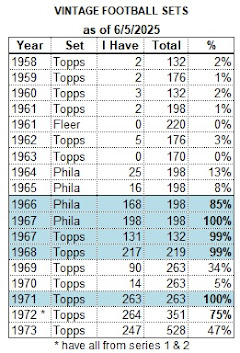Tuesday, June 15, 2021
Houston Oilers
Wednesday, September 30, 2020
Cincinnati Bengals
Wow, I've been very lax with my football card blogs for the past few weeks months years. (Cardinals - April 2014; Bills - July 2016; It seems like I should have posted something in 2018.)
Well, this Bengals post has been sitting in draft mode since January 2018. As I recall, I had it mostly completed when the Blogger gremlins attacked. In the middle of me typing something, the cursor highlighted all the text, therefore replacing everything with whatever character I last typed. Immediately, autosave kicked in, wiping out everything I did. AARGH! I hate when that happens.
That happened a few times on my baseball blogs (Tommie Agee, Joe Rudi, maybe others), so since November 2012 I have been composing my baseball posts in Word documents, then pasting them into Blogger. (I haven't learned that lesson yet for my football blogs.)
So my new football blog format (as detailed here) is to scan the cards in groups of 8 or 9, to minimize the number of scans per post (which is what is mostly holding me back).
Sunday, June 21, 2020
RIP - Jim Kiick
Kiick was drafted by the Dolphins in 1968, and was their starting halfback for the next 4 seasons, teaming up with fullback Larry Csonka in their "Butch Cassidy and the Sundance Kid" backfield. Kiick made the Pro Bowl in his first 2 seasons, and led the AFL with 9 rushing touchdowns in 1969.
In 1972 and 1973 he only started a handful of games, as Mercury Morris became the featured halfback. Kiick was used primarily on passing downs and short-yardage situations.
In 1974 he started half the games, but that was his final season with Miami.
He joined Dolphins' teammates Csonka and Paul Warfield on the WFL's Memphis team for the 1975 season. The league folded before the end of the season, so he was back in the NFL in 1976.
Although wanting to join Csonka with the 1976 Giants, he ended up with the Denver Broncos. He was released late in the 1977 season, but caught on with the Redskins for 1 game, then retired after the season.
Obituary
Monday, April 20, 2020
RIP - Mike Curtis
Curtis was the Colts' #1 pick in the 1965 draft. He made the Pro Bowl 5 times between 1968 and 1974.
Mike played in Super Bowls III and V. His late-game interception set up the Colts' last-second winning field goal in Super Bowl V.
In 1971 he famously decked a fan for running out on the field during a game.
Curtis later played for Seattle and Washington from 1976-78.
Here's Mad Dog being Mad Dog:
here and here
NBC Sports obituary
Touchdown Wire
Saturday, April 18, 2020
Hall of Famers
I have 9 more teams to post on this 1971 blog, but that can wait for awhile. I needed something more interesting for a comeback post.
These are the 54 Hall of Famers in the 1971 Topps set. There were 261 players (+ two checklists) in the set, but before we decide that a 20% ratio of HOFers is a large chunk, keep in mind that before 1973 only the top 8 to 10 players on each team had a card anyway.
Re-cap:
6 - Chiefs (way to matriculate into Canton, fellas!)
4 - Dolphins, Raiders, Rams
3 - Cardinals, Cowboys, Lions, Packers, Redskins, Vikings
2 - Bears, Browns, Colts, 49ers, Jets, Steelers
1 - Bills, Broncos, Chargers, Falcons, Giants, Oilers
0 - Bengals, Eagles, Patriots, Saints








































